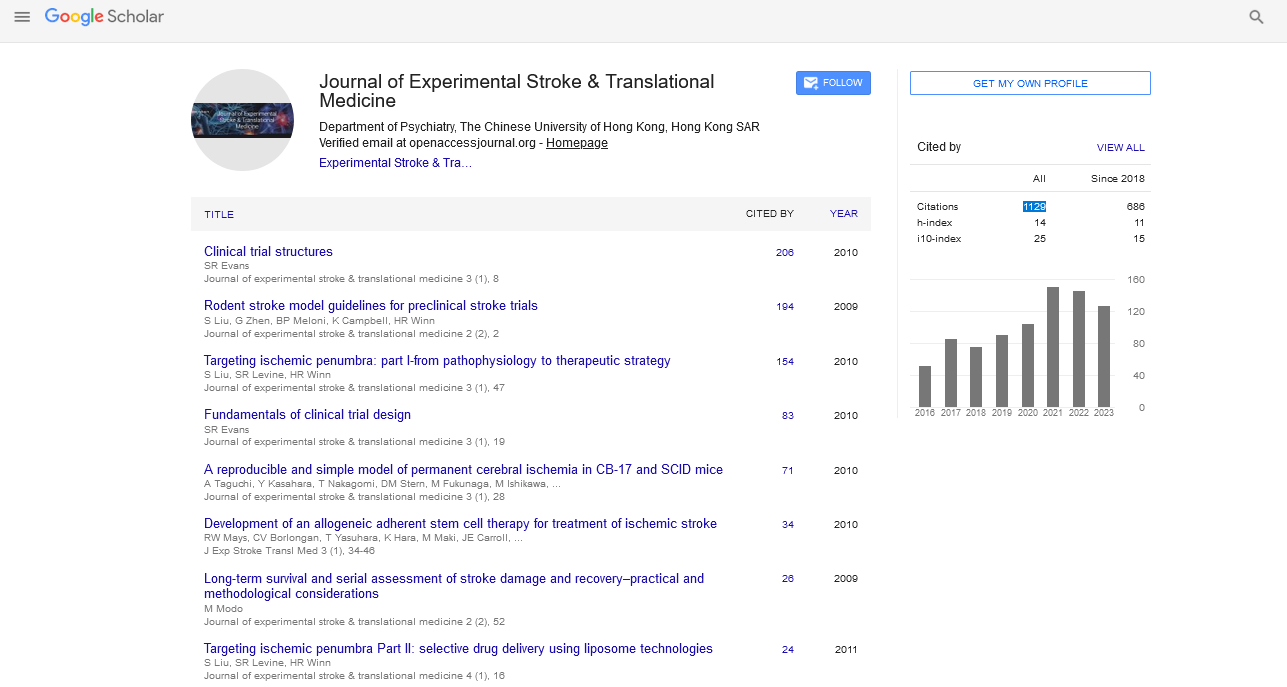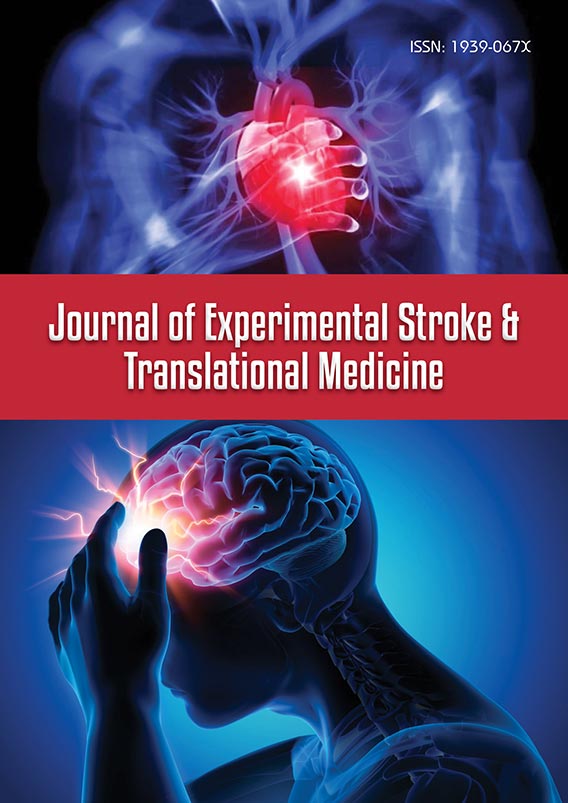Perspective - Journal of Experimental Stroke & Translational Medicine (2025) Volume 17, Issue 1
Navigating the Brain: Advanced Neuroimaging Revolutionizes Stroke Diagnosis
Hussein Yosef*
Department of Neurology, Istanbul University, Istanbul, Turkey
*Corresponding Author:
Department of Neurology, Istanbul University, Istanbul, Turkey
E-mail: huseinahmedyousef@gmail.com
Received: 27-Nov-2023, Manuscript No. JESTM-23-121187; Editor assigned: 29-Nov-2023, PreQC No. JESTM-23-121187 (PQ); Reviewed: 13-Dec-2023, QC No. JESTM-23-121187; Revised: 13-Feb-2025, Manuscript No. JESTM-23-121187 (R); Published: 20-Feb-2025, DOI: 10.37532/JESTM.2025.17(1).295-296
Introduction
In the intricate world of neurological disorders, stroke stands as a formidable adversary, demanding swift and accurate diagnosis for optimal patient outcomes. The evolution of neuroimaging technologies has revolutionized the landscape of stroke diagnosis, enabling clinicians to delve deep into the complexities of the brain’s vasculature and tissue. This article explores the transformative power of advanced neuroimaging in stroke diagnosis, shedding light on the innovative techniques that are reshaping the way we perceive, understand, and treat this critical medical condition.
Description
The urgency of stroke diagnosis
Stroke, often referred to as a “brain attack,” requires rapid intervention to minimize damage and improve patient prognosis. Traditionally, the diagnosis of stroke relied on clinical assessment, medical history, and conventional imaging techniques such as Computed Tomography (CT) and Magnetic Resonance Imaging (MRI). While these methods remain essential, advanced neuroimaging has elevated the precision and speed of stroke diagnosis, offering a more comprehensive understanding of the underlying pathology.
Multimodal imaging: Painting a comprehensive picture
One of the key advancements in stroke diagnosis is the integration of multimodal imaging, which combines various imaging techniques to provide a comprehensive view of the brain. This approach goes beyond capturing structural abnormalities and includes functional and perfusion information, allowing clinicians to assess the extent of tissue damage, identify the type of stroke, and tailor interventions accordingly.
CT perfusion imaging: Unveiling the dynamics
Computed Tomography Perfusion imaging (CTP) is a cutting-edge technique that provides real-time information about blood flow in the brain. By injecting a contrast agent and tracking its passage through the cerebral vasculature, CTP generates dynamic maps that reveal areas of reduced blood flow, known as ischemic regions. This information is crucial in determining the viability of brain tissue and guiding decisions on reperfusion therapies.
Diffusion-Weighted Imaging (DWI): Capturing the microscopic changes
Within the realm of advanced MRI, Diffusion- Weighted Imaging (DWI) has become a cornerstone for stroke diagnosis. DWI detects microscopic changes in water diffusion within tissues, allowing for the early identification of ischemic areas. The sensitivity of DWI enables clinicians to pinpoint the location and size of the infarct, facilitating timely and precise interventions.
Perfusion MRI: Mapping the terrain
Perfusion MRI is another invaluable tool in the neuroimaging arsenal for stroke diagnosis. By tracking the passage of a contrast agent through the brain, perfusion MRI creates maps that illustrate the regional distribution of blood flow. This information aids in distinguishing between ischemic and healthy tissue, guiding therapeutic decisions and providing insights into the overall hemodynamic status of the brain.
CT angiography and magnetic resonance angiography: Navigating the vasculature
Understanding the vascular anatomy is crucial in stroke diagnosis, and advanced angiographic techniques play a pivotal role in achieving this. CT Angiography (CTA) and Magnetic Resonance Angiography (MRA) offer high-resolution images of the blood vessels, enabling clinicians to identify occlusions, stenosis, or other abnormalities that may contribute to stroke. These non-invasive techniques have revolutionized the assessment of the cerebral vasculature, providing a roadmap for potential interventions.
Functional MRI (fMRI): Unmasking brain activity
Beyond structural and perfusion imaging, functional MRI (fMRI) adds a layer of sophistication by revealing the functional activity of the brain. In stroke diagnosis, fMRI can help identify eloquent areas of the brain, assess the impact of the stroke on neural networks, and predict the potential for functional recovery. This information is invaluable in tailoring rehabilitation strategies to optimize outcomes.
Artificial intelligence and machine learning: Augmenting expertise
The integration of Artificial Intelligence (AI) and machine learning algorithms represents a paradigm shift in neuroimaging for stroke diagnosis. These algorithms can analyze vast amounts of imaging data rapidly, assisting clinicians in identifying subtle patterns, predicting outcomes, and enhancing diagnostic accuracy. The synergy between human expertise and AI capabilities holds immense potential in streamlining the diagnostic process and personalizing treatment approaches.
Challenges and future directions
While advanced neuroimaging has undoubtedly transformed stroke diagnosis, challenges persist. Accessibility to these sophisticated techniques, particularly in resource-limited settings, remains a concern. Additionally, the interpretation of multimodal imaging requires expertise, highlighting the need for ongoing training and education for healthcare professionals. The future holds the promise of addressing these challenges through continued technological advancements, improved accessibility, and enhanced collaboration between disciplines.
Conclusion
Advanced neuroimaging has ushered in a new era in stroke diagnosis, enabling clinicians to unravel the intricacies of the brain with unprecedented precision. From multimodal imaging techniques that paint a comprehensive picture of cerebral perfusion to the integration of artificial intelligence for rapid and accurate analysis, the arsenal of neuroimaging tools continues to expand. As technology evolves and our understanding of stroke pathology deepens, the synergy between advanced neuroimaging and clinical expertise promises to redefine how we diagnose, understand, and treat strokes, ultimately leading to better outcomes for patients facing this critical medical condition.

